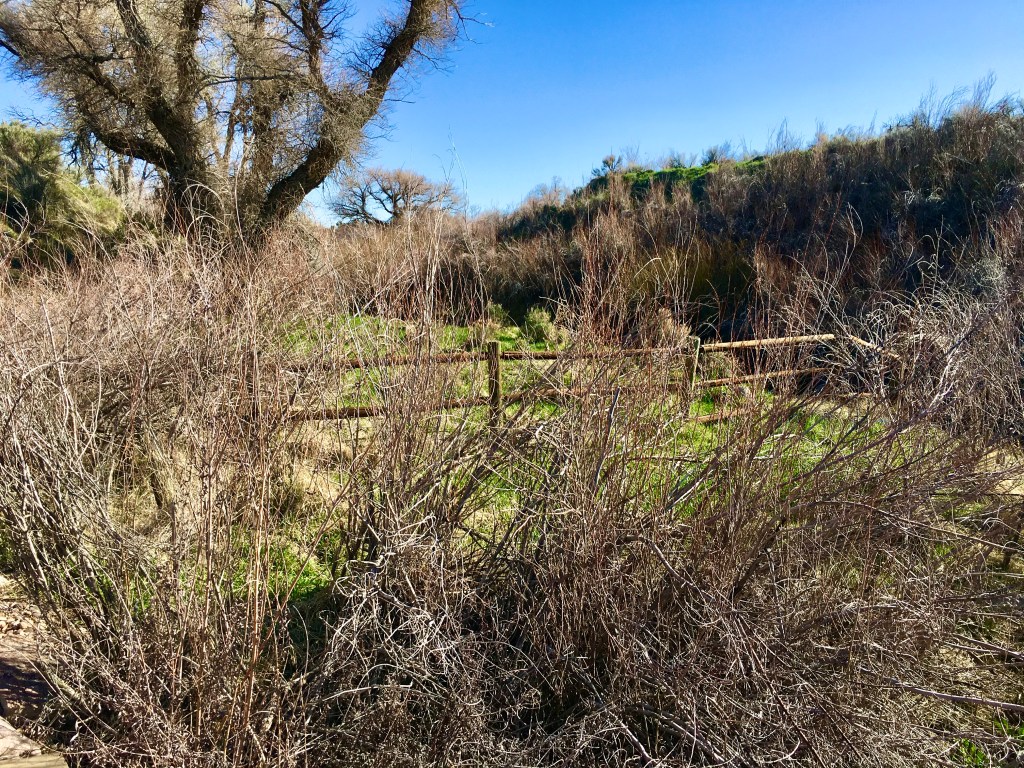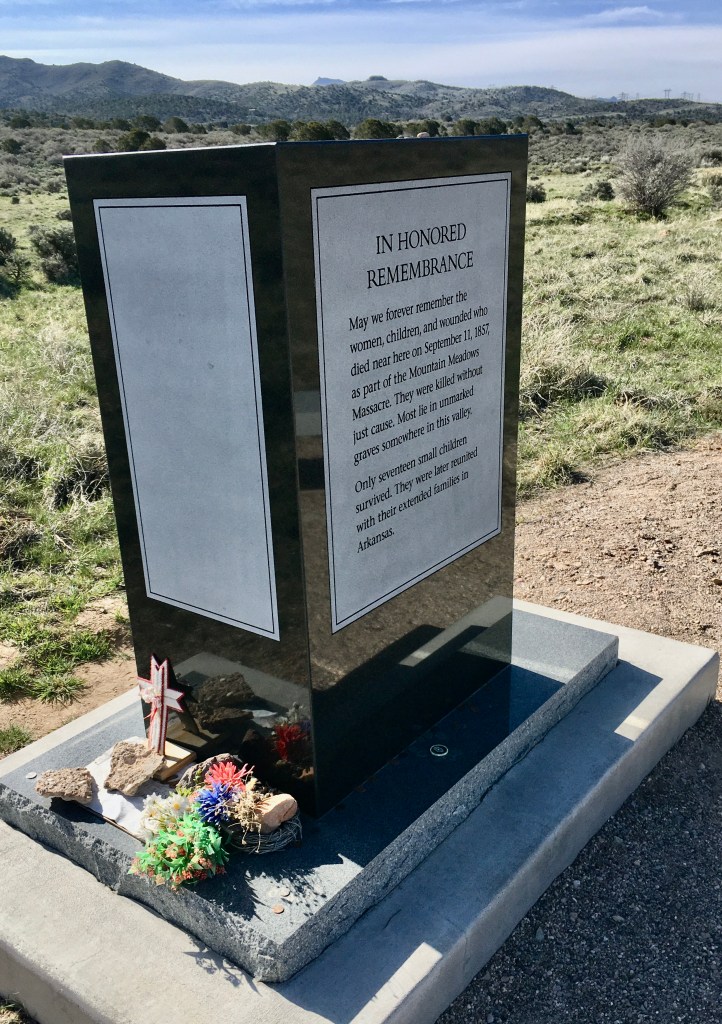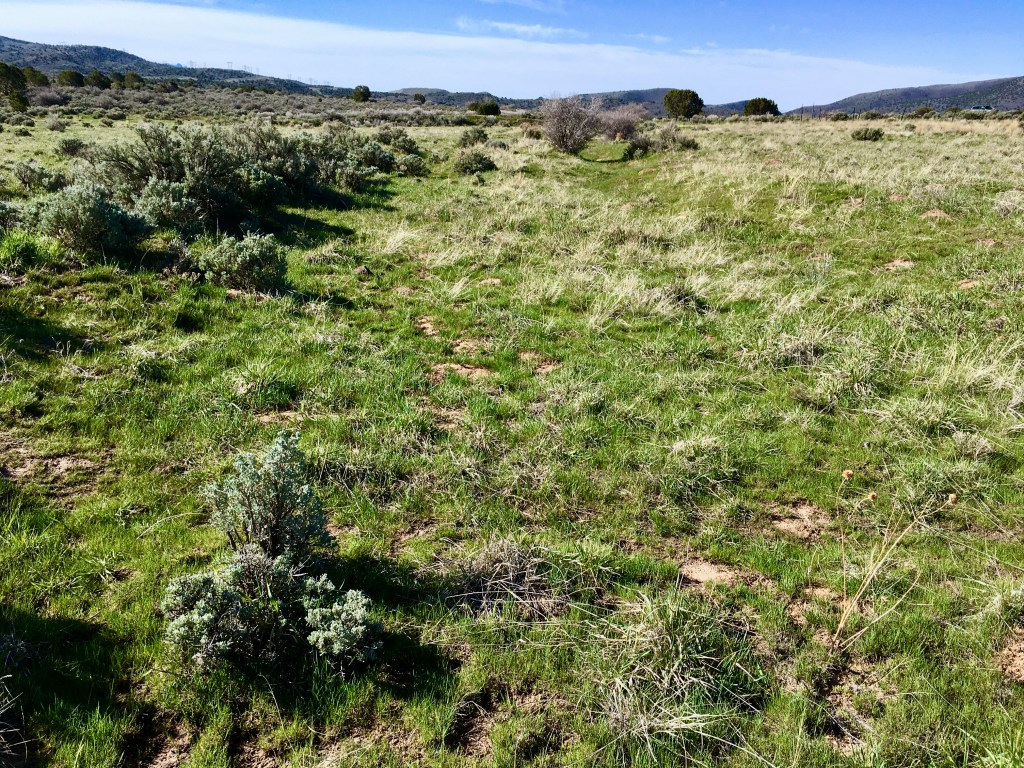On a recent trip to Utah, I stayed in St. George for a night. While there, I decided to drive north into the Bull Valley Mountains to visit the site of the Mountain Meadow Massacre, an event that has long fascinated me.
1857 was a tumultuous time in the Mormon ruled enclave with mounting pressure from the United States government to end polygamy, and rampant fear among the Saints of attack by Federal forces at any time. Westward bound wagon trains headed for California traveled the road through Mormon lands with increasing frequency. The Baker-Fancher wagon train was larger than most, and wealthier.
Mormons near St. George were consumed with war hysteria and imagined the stream of emigrants to be spies or worse. When rumors reached them that members of the Baker-Fancher wagon train had treated residents along the road badly, the local Mormon militia designed a plan to discourage travel through the territory. When the train arrived at the foothills and inquired about a place to camp in the mountains, the local Mormons sent them to a large mountain meadow area with plentiful grass for their stock and a spring and stream for fresh water.
The travelers found the mountain meadow as described and happily settled in to rest and prepare for a more arduous part of their journey ahead. They circled their wagons defensively, as always, as a caution. Nevertheless, the ensuing attack was a great surprise.
The local Indians, the Shivwits, were a branch of Southern Paiute existing peacefully under the thumb of the Mormons. The Mormon militia convinced the reluctant Indians to join them in the attack, claiming that the large well-armed wagon train planned to do harm to them. But the Mormons would dress like the Shivwits to cause the travelers to believe the attack was purely by Indians. The plan failed.
The Baker-Fancher party put up a stout defense and the battle went on for days. At several points, the faux Indians’ white skin was exposed, and the Mormons realized the besieged were not fooled. They also realized if word got out, the U.S. forces would have the very excuse they needed to invade Mormon territory. Hoisted on their own petard, the Mormon leaders decided no member of the wagon train could be allowed to survive. The Shivwits, meanwhile, left in disgust.
Eventually, the Baker-Fancher party ran low on supplies and, in a desperate situation, acceded to a conditional surrender with assurances they would be protected. They gave over their guns, as requested, and were marched a distance away from their defensive positions. There, they were divided into two groups: men and boys, women and girls. The two groups were led off. After a short distance, the men and boys were held up while the women marched on. The women were able to hear the sounds of the guns that slaughtered the men. Shortly after, they too were shot down. The very youngest children were kept back in the wagons, most to be dispatched, a few to be brought up by Mormon families.
The bodies lay where they were, becoming bleached bones until finally discovered. The Mormons kept their secret for more than a decade and investigations were slowed by the Civil War, but eventually the truth became known. One man, a scapegoat for all Mormon conscience, was hanged.
I found the site understated but poignant in its design. It was organized into four locations––a hill overlooking the whole valley meadow, the location of the Baker-Fancher campsite, the execution site of the men, and that of the women. From the hilltop observation memorial, spotter scopes permanently set to view each execution site bring the horror vividly into focus.

I toured each of the four locations and came away with impressions from each. The hilltop memorial allows a global perspective of a valley, gained by a gently ascending slope from the east toward a long, narrow but lush meadowland, and beyond it (where the wagon train was never destined to travel) a maze of steep hills and deep ravines, causing me to wonder if a route beyond even existed. The campsite itself struck me as a lovely place, from the dell-like stream bed to the gentle sunny meadow, unchanging despite human perfidy.
The site of the men’s execution was in a small stand of trees, stark and lonely. The women’s execution site was in an open meadow, marked by a memorial. Here the sun’s warmth reached resurgent grasses. Behind the pyramid, one may still see the ruts of wagons. A quarter mile away stands a house, one occupied at the time of the killings, where the widow who lived there later confessed to hearing the gunfire.
Today, surrounded as we are by a cacophony of brutality and murder, I recognize an insulation I’ve constructed within myself to protect against the overwhelming emotion that would otherwise prevent living a normal life. It is possible to do so only by distancing and obscuring the horrific detail of such events. It was jarring to visit this site of meaningless mass murder, but the exposure centered anew in me the recognition of the long, slippery slope of denial into an acceptance of evil.



We cannot walk away from our history. We cannot tear down statues and throw away books thinking that it will change what happened in the past to mollify a few peoples egos. To me the past’s glaring mistakes have always been a reminder of not to make those mistakes again.
I couldn’t agree more!
Thank you for this brief history in Wyoming, I learned about this horrible act at the Senior Center here in Shoshoni years ago. I have wanted to know more than just that a massacre took place. I hope to learn more. One lady had a book that was out of print that told about this. She is gone now and I can not get that book.
There is information on-line if you Google Mountain Meadows Massacre. Best luck.